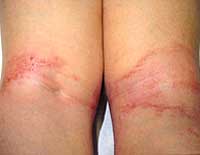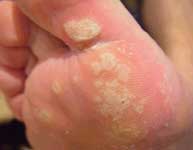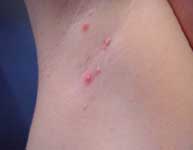López Gil Francisco José
Dermatology
Atopic dermatitis
How do I know if my child has atopic dermatitis? (Eczema)
 If any member of the family is/was asthmatic or had/ has rhinitis or dermatitis.
If any member of the family is/was asthmatic or had/ has rhinitis or dermatitis.- If the dermatitis starts to appear when the child is between 3 months and 1 year old
- If the skin is very dry and sometimes there are outbreaks of redness with flaky itchy skin and small blisters which contain liquid especially if this happens in precise areas of the body.
How can we treat atopic dermatitis?
Prevention and Care
- It is much better to have showers rather than baths as the prolonged contact with water will over dry the skin. Also it is always recommended to use dermatological soap.
- Always use moisturising creams or lotions after bathing. These should be free of alcohol, dyes and fragrances and should lubricate the skin well.
Medical Treatment
- Topical corticosteroids: This is the most common form of treatment for acute outbreaks. It is not harmful if only used for short periods of 2-3 weeks. If the child needs a longer course of treatment it is important to use products that do not contain cortisone.
- The most efficient way of preventing the outbreaks is always keeping the skin well hydrated. The difficulty lies in finding a cream that sufficiently hydrates the skin of a child with this type of eczema.
The most common infectious childhood diseases
Warts and Verrucas

- What are they?
Warts are caused by a viral infection (human papillomavirus or HPV) and are contagious. They spread easily from person to person through contact with broken skin. They also spread in the same person's body by scratching.
- Who do they affect and what types of warts are there?
Children of school age are the most affected and children who have eczema will have a much higher susceptibility as they are more prone to skin infections in general. The most common forms of warts are the common warts and verrucas which are found on the feet. - How do you treat them?
It is important that treatment is supervised by a doctor to avoid cases of anti-wart products being used on moles, angiomas, cysts and other undiagnosed lesions.xxxxxxx Currently there are no treatments that cure viruses but warts or verrucas can be removed using different methods according to their location:- Cryotherapy: (cold liquid nitrogen) is the most common treatment for warts either on its own or combined with chemical agents.
- Laser: The Erbium laser is a good choice to destroy warts especially if found on the face as it will not leave marks or scars.
Molluscum contagiosum

- What is it and how do you get it?
It is a viral infection of the skin (poxvirus) that produces small 2-5mm bumps that look like pearls (also known as water warts). They can either appear individually or in groups, are not painful nor itch but are very contagious. They are very common in childhood above all in people who have atopic skin. - Do you have to treat it or does it disappear on its own?
The bumps have a tendency to spread so it is always best to have the area concerned treated. - What treatments are available?
- Cryotherapy The bumps are destroyed by applying a freezing cold temperature which is carried out after applying local anesthetic cream. It is painless and the bumps will disappear within 8-10 days of having the treatment.
Contact us
Centro Médico Teknon
López Gil Francisco José
Vilana offices (offices 126, 127 y 165)
Vilana, 12
08022 Barcelona
Emergency Phone Number: 620 20 75 21 / +34 93 393 31 65 / + 34 93 254 64 71 / +34 93 393 31 27
Schedules
| Morning | Afternoon | |
|---|---|---|
| Monday | 09.30 - 13.30 h | 15.30 - 19.00 h |
| Tuesday | 09.30 - 13.30 h | 15.30 - 19.00 h |
| Wednesday | 09.30 - 13.30 h | 15.30 - 19.00 h |
| Thursday | 09.30 - 13.30 h | 15.30 - 19.00 h |
| Friday | 09.30 - 13.30 h | 15.30 - 19.00 h |















